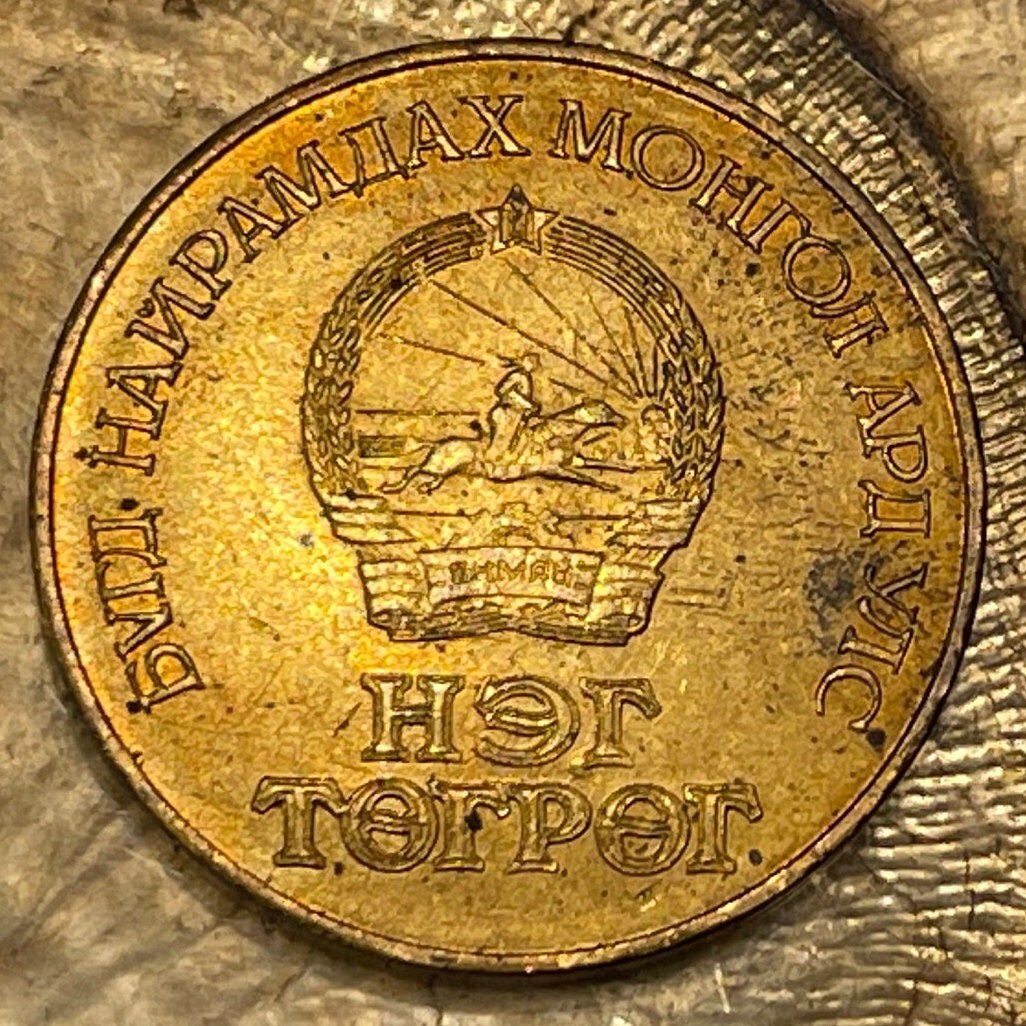elemintalshop
Revolutionary Damdin Sükhbaatar on Horse 1 Tögrög Mongolia Authentic Coin Money for Jewelry (Father of the Revolution) 50 Anniversary (1971)
Revolutionary Damdin Sükhbaatar on Horse 1 Tögrög Mongolia Authentic Coin Money for Jewelry (Father of the Revolution) 50 Anniversary (1971)
Couldn't load pickup availability
Revolutionary Damdin Sükhbaatar on Horse 1 Tögrög Mongolia Authentic Coin Money for Jewelry and Craft Making (Father of the Mongolian Revolution) (50th Anniversary) (1971)
Commemorative issue: 50th Anniversary of the Mongolian Revolution
Reverse: Man on horse left within beaded circle - the monument to Damdinii Sükhbaatar (was a founding member of the Mongolian People's Party) in Ulan Bator.
БНМАУ (Бүгд Найрамдах Монгол Ард Улс) – BNMAU (Bügd Nairamdakh Mongol Ard Uls), Mongolian People's Republic.
Lettering: БНМАУ
50 ЖИЛ
Translation: BNMAU
50 years
Obverse: Emblem of the People's Republic of Mongolia (1960-1992); denomination.
Lettering:: БҮГД НАЙРАМДАХ МОНГОЛ АРД УЛС
НЭГ
ТӨГРӨГ
Translation: The Mongolian People's Republic
One Tögrög
Edge
Smooth with inscription
Lettering: 1921 - 1971 * НЭГ ТӨГРӨГ *
Translation: One Tögrög
Features
Issuer Mongolia
Period People's Republic (1924-1992)
Type Circulating commemorative coin
Year 1971
Value 1 Tögrög (1 MNT)
Currency Tögrög (1925-date)
Composition Aluminium-bronze
Weight 14.9 g
Diameter 32 mm
Thickness 2.65 mm
Shape Round
Technique Milled
Orientation Medal alignment ↑↑
Demonetized Yes
Number N# 10114
References KM# 34
Wikipedia:
Damdin Sükhbaatar (Mongolian: Дамдины Сүхбаатар, Damdinii Sykebaatar, ᠳᠠᠮᠳᠢᠨ ᠤ
ᠰᠦᠬᠡᠪᠠᠭᠠᠲᠤᠷ; February 2, 1893 – February 20, 1923) was a founding member of the Mongolian People's Party and leader of the Mongolian partisan army that took Khüree during the Outer Mongolian Revolution of 1921. For his part in the Outer Mongolian revolution of 1921, he was enshrined as the "Father of Mongolia's Revolution".
********
Wikipedia:
The Mongolian Revolution of 1921 (Outer Mongolian Revolution of 1921, or People's Revolution of 1921) was a military and political event by which Mongolian revolutionaries, with the assistance of the Soviet Red Army, expelled Russian White Guards from the country, and founded the Mongolian People's Republic in 1924. Although nominally independent, the Mongolian People's Republic was a satellite state of the Soviet Union until a third Mongolian revolution in January 1990. The revolution also ended the Chinese Beiyang government's occupation of Mongolia, which had begun in 1919. The official Mongolian name of the revolution is "People's Revolution of 1921" or simply "People's Revolution" (Mongolian: Ардын хувьсгал).
Wikipedia:
The Mongol horse (Mongolian Адуу, aduu: "horse" or mori; or as a herd, ado) is the native horse breed of Mongolia. The breed is purported to be largely unchanged since the time of Genghis Khan. Nomads living in the traditional Mongol fashion still hold more than 3 million animals, which outnumber the country's human population. In Mongolia, the horses live outdoors all year, dealing with temperatures from 30 °C (86 °F) in summer down to −40 °C (−40 °F) in winter, and they graze and search for food on their own. The mare's milk is processed into the national beverage airag. Some animals are slaughtered for meat. Other than that, they serve as riding and transport animals; they are used both for the daily work of the nomads and in horse racing.
Mongol horses were a key factor supporting the 13th-century conquests of the Mongol Empire.
The Mongols have many stories and songs about horses. Legendary horses include magical flying steeds, beloved horses that visit in dreams, and a rich body of folklore about equine protagonists. The horse has long played a role as a sacred animal, and Mongols have a variety of spiritual beliefs regarding them. The mane is believed to contain a horse's spirit and strength; for this reason, the mane of stallions is always left uncut. Mare's milk has been used in ceremonies of purification, prayer, and blessing since antiquity. In modern times, it continues to be used in a variety of ceremonies associated with racing. Historically, horses were sacrificed on special occasions; 40 horses were sacrificed at the funeral of Genghis Khan.[29] When a horse is killed, a variety of rituals may be followed to honor the remains. Horses are believed to have spirits that can help or hurt their owner after death. When a deceased horse's spirit is content, the owner's herd will flourish; if not, then the herd will fail.
********
From 1960 to 1991, the Mongolian People's Republic used an emblem with a very similar shape, but with several differing elements, from their previous longstanding symbols.
Instead of the traditional Wind Horse (a shamanic spirit-being), a horseman on a normal horse is shown.
In the background, the sun rises above mountains. The older Buddhist symbols are replaced by symbols of Socialism.
A gearwheel stands for industrialization, sheaves around the perimeter stand for the farming class, and the top featured a red star with the socialist version of the Soyombo.
Along the bottom, a blue-red ribbon is placed in front of the gearwheel, with the letters БНМАУ, the abbreviation for Бүгд Найрамдах Монгол Ард Улс, (Mongolian People's Republic).
Before 1961, the emblem did not bear most of these socialist symbols.
Share










5 stars review from Karl









